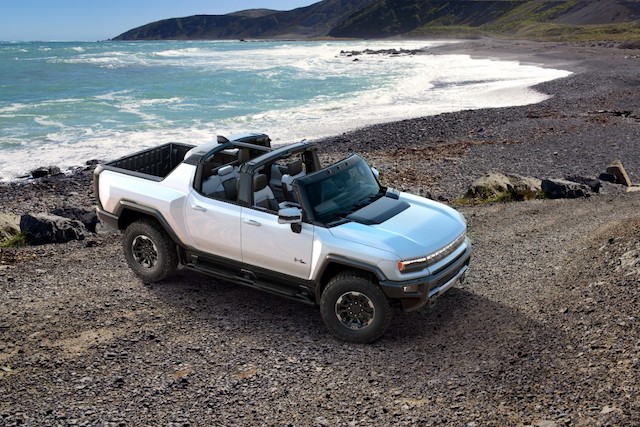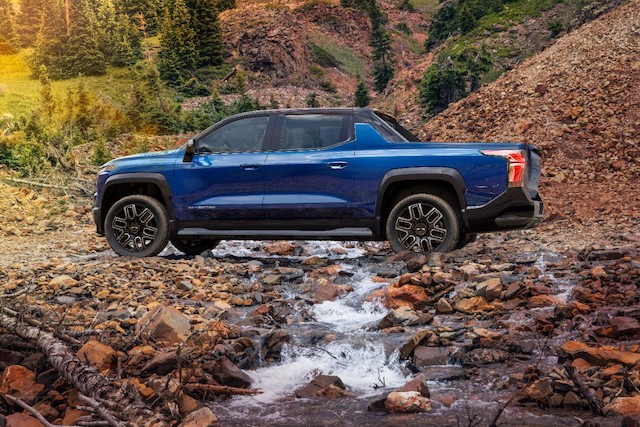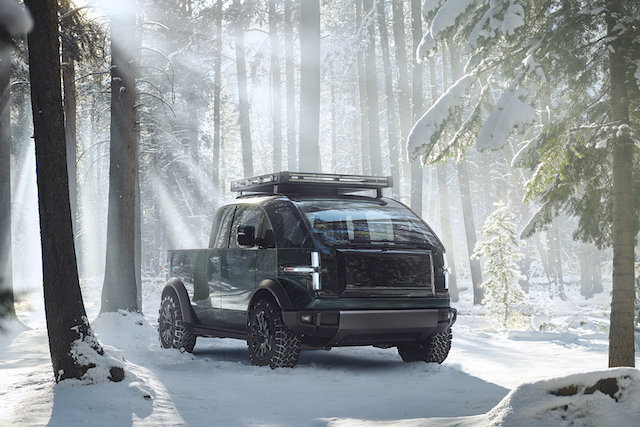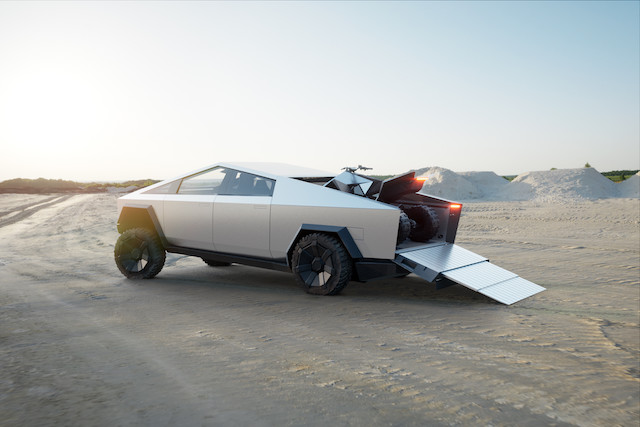It may not have garnered front-page headlines, but a major milestone in automotive history was reached last fall. It took place in the otherwise quiet, ironically named town of Normal, Illinois. There and then, electric vehicle startup Rivian rolled its first consumer-ready vehicle off the assembly line, instantly becoming the first electric pickup truck brought to market.
Pickup trucks represent the final frontier in electric vehicles, which have quickly evolved from tiny sedans to SUVs. The market for the emission-free trucks is expected to grow significantly over the next several years. In other words, the Rivian R1T‘s time in the spotlight alone is coming to a close. It will soon be sharing the stage with a host of competitors. In fact, a number of new electric pickup truck models are right around the corner. Some are already in production, others won’t be available until 2023 (hopefully). Either way, expect to see these vehicles driving on a street near you in the not-so-distant future.

GMC Hummer
The aughts were full of trends we can safely say the world is better off without. Chief among them was the popularity of the gas-guzzling Hummer. But in true 2020s fashion, the truck has been rebooted with a new owner (GMC) and a new way of moving.
While it was once antithetical to use the terms “Hummer” and “environmentally friendly” in the same sentence, this new, fully electric version is entirely emission free. It’s compatible with the fastest available chargers, enabling owners to gain nearly 100 miles of range in just 10 minutes of charging. The Hummer EV can travel more than 320 miles on a full charge.
The electric pickup truck, which went into production late last year, does have one thing in common with its gas-powered ancestor: it’s a beast of a vehicle. Powered by three separate motors, the Hummer EV produces an unparalleled 1,000 horsepower and 11,500 lb.-ft. of torque. All that strength comes at a price, however. The Edition 1 model came with a price tag north of $110,000. Less expensive versions will be available beginning in the fall.
https://www.youtube.com/watch?v=oc3sQ2UcTlg&list=PLCFM1h5Oz66glrCg2NISP1eYsfcQ6EfIb
Ford F-150 Lightning
Few automobiles have garnered as much pre-manufacturing publicity as the Ford F-150 Lightning. But, then again, few automobiles have had the potential to truly revolutionize American driving. The gas-powered F-150 has been the best-selling vehicle in the U.S. for nearly half a century. Converting owners of the traditional model to those of the Lightning could go a long way in helping EVs carve out a larger percentage of overall cars on the road.
And it appears the Lightning has already struck a chord with pickup truck drivers. In January, Ford announced it would be doubling its production 150,000 trucks per year after receiving 200,000 initial reservations. (For context, there were roughly 725,000 Ford F-150s sold in 2021).
Owners should be more than satisfied when they finally get behind the wheel of the Lightning, which is set to hit the road this spring. The emission-free pickup delivers 563 horsepower, 10,000-pound towing capacity and a F-150 record 775 lb.-ft. of torque. It also is the first vehicle ever with the extremely convenient ability to power your house.
GMC Sierra Denali EV
Not resting on its laurels, GMC is coming out with a second electric pickup truck right on the Hummer’s heels. The Sierra Denali EV’s debut will make GMC the first automaker to offer two such vehicles.
Although it’s set to be revealed later this year, not much is known about the truck yet. The car maker offered a glimpse of the vehicle’s futuristic front end but has offered few other details so far. We do know the pickup truck will be a luxurious one – “Denali” is GMC’s highest trim level.

Chevrolet Silverado
The F-150 may be America’s best-selling vehicle, but the Silverado is not far behind. Drivers purchased more than half a million units of the Chevy truck in 2021, making it the year’s third most-popular automobile. And just like its chief competitor, there will soon be an electric version.
The Silverado EV isn’t set to debut until the spring of 2023, but the payoff may be worth the wait. According to Chevrolet, the pickup truck will have up to 664 horsepower, more than 780 lb.-ft. of torque and be capable of supporting a payload of 1,300 pounds, all while getting from 0-60 mph in less than 4.5 seconds. Those concerned about driving range can sleep easy knowing the Silverado EV is expected to travel an estimated 400 miles on a full charge. Potential owners may also be lured by the opportunity to play hero to stranded motorists as the pickup truck will be capable of charging other EVs courtesy of an accessory charge cord.

Canoo Pickup
Those looking to couple their advanced technology with futuristic design can wait on bated breath for the Canoo Pickup. Slated to launch as early 2023, the vehicle is complete with an onslaught of features designed to appeal to those using it for work and fun. The Canoo’s modular bed allows it to be divided to hold and secure loads of various shapes and sizes. Speaking of cargo, the vehicle has a payload capacity of a full-size pickup, but the footprint of a mid-size. Other work-focused features include multiple fold-down tables and charge ports accessible from all sides of the vehicle.
When the weekend arrives, Canoo owners can store their gear on the optional roof rack, which is easily accessible by an integrated step ladder. The innovative pickup is also designed to accommodate camper shells.

Tesla Cybertruck
The only thing more confusing than the Cybertruck’s appearance is its production timeline. When it was originally unveiled in 2019, Tesla claimed the Cybertruck would be available by late 2021. Before that could happen, production was delayed until 2022. In January, Tesla announced it wouldn’t begin manufacturing until 2023, citing supply chain issues. This coincided with the car maker ridding its website of any references to a production schedule.
For the sake of some much-needed optimism, let’s assume the Cybertruck will indeed be available sometime next year. When that happens, consumers will be privy to a vehicle unlike any they’ve ever seen – assuming Tesla’s claims come true. The pickup’s DeLorean-style monochrome shell is nearly impenetrable. The 100-cubic-feet of exterior storage space can handle 3,500 pounds and be completely covered by a tonneau strong enough to stand on. All this in an electric pickup truck capable of accelerating from 0-60 mph in less than 3 seconds and covering 500 miles on a single charge.
Visit AAA’s Electric Vehicle platform for more information on these cars of the future.
Ready to get behind the wheel of an electric pickup truck (or any new vehicle)? Make sure to download our Free Car Buying Guide, which walks you through every step of the process.
9 Thoughts on “All the Electric Pickup Trucks on the Horizon”
Leave A Comment
Comments are subject to moderation and may or may not be published at the editor’s discretion. Only comments that are relevant to the article and add value to the Your AAA community will be considered. Comments may be edited for clarity and length.














All of these trucks seem to be crew cabs. Are standard cabs and extended cabs on their way out? As much as I would like to have an electric pickup, I wouldn’t be interested in having a crew cab. I want a choice.
Where are the 6.5-8 foot beds?
Are these just toys or are they going to be work vehicles as well?
No thank you! I will stick with my gas powered pickup and not have to worry about finding a charging station. I wouldn’t want to run out of battery life stuck on a snow covered Interstate in subzero weather. The battery will quickly drain running the heating and other accessories.
A PHEV implementation could allay those concerns. I hope that the long rumored and prototyped PHEV Ford Ranger yet emerges, along with plug-in Hybrid pickups from other vendors.
The manufacturers are going to have to patent their own “Vroom! Vroom!” (a la Harley Davidson) or they’re going to be missing a bet and a market segment. This is about the macho thing.
“Half humor, whole serious,” as the saying goes.
What happens when you put Evs in Salty New England winters and snowy salt covered pothole roads?
What has happened? I’m old, too, so I really don’t know.
But then, it could be that the answer is nothing.
What does that mean?
Have there been such problems?